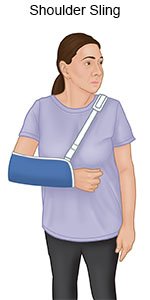Clavicle Fracture
Medically reviewed by Drugs.com. Last updated on Aug 4, 2025.
AMBULATORY CARE:
A clavicle fracture
is a break in your clavicle (collarbone).
 |
Common signs and symptoms include the following:
- Pain at the clavicle or top of the shoulder, especially with shoulder movement
- Trouble moving your shoulder or arm
- Swelling or bruising
- Weakness, numbness, or tingling in your shoulder and arm
- Lump or bulge in the fractured area
- Deformed clavicle, or clavicle that looks out of place
- Shoulder slumps down and forward
- Support of your arm with the other hand to decrease pain
Seek care immediately if:
- Your shoulder, arm, hand, or fingers turn blue or pale, or feel cold or numb.
- Your pain gets worse, even after rest and medicine.
- Your splint feels tight, or you have increased swelling.
- You cannot move your fingers.
Call your doctor if:
- Your sling or wrap comes off or gets damaged.
- You have questions or concerns about your condition or care.
Treatment
will depend on the damage and the kind of fracture you have. Most broken clavicles heal on their own. It is very important to keep your arm from moving to allow the clavicle to heal. You may need any of the following:
- Acetaminophen decreases pain and fever. It is available without a doctor's order. Ask how much to take and how often to take it. Follow directions. Read the labels of all other medicines you are using to see if they also contain acetaminophen, or ask your doctor or pharmacist. Acetaminophen can cause liver damage if not taken correctly.
- NSAIDs , such as ibuprofen, help decrease swelling, pain, and fever. This medicine is available with or without a doctor's order. NSAIDs can cause stomach bleeding or kidney problems in certain people. If you take blood thinner medicine, always ask your healthcare provider if NSAIDs are safe for you. Always read the medicine label and follow directions.
- A sling or brace will be recommended to keep your clavicle from moving so it can heal. It will also help decrease pain.

- Surgery may be needed to return the bones to their normal position. Pins, plates, and screws may be used to hold the bone together.
Manage a clavicle fracture:
- Rest will help your clavicle heal. Limit your activity as directed.
- Apply ice on your clavicle for 15 to 20 minutes every hour or as directed. Use an ice pack, or put crushed ice in a plastic bag. Cover the bag with a towel before you apply it to your clavicle. Ice decreases swelling and pain.
- Physical therapy may be recommended after your clavicle heals. A physical therapist teaches you exercises to help improve movement and strength, and to decrease pain.
Follow up with your doctor within 1 week or as directed:
You may need to return for more x-rays to see how well your clavicle is healing. Write down your questions so you remember to ask them during your visits.
© Copyright Merative 2025 Information is for End User's use only and may not be sold, redistributed or otherwise used for commercial purposes.
The above information is an educational aid only. It is not intended as medical advice for individual conditions or treatments. Talk to your doctor, nurse or pharmacist before following any medical regimen to see if it is safe and effective for you.
Further information
Always consult your healthcare provider to ensure the information displayed on this page applies to your personal circumstances.
